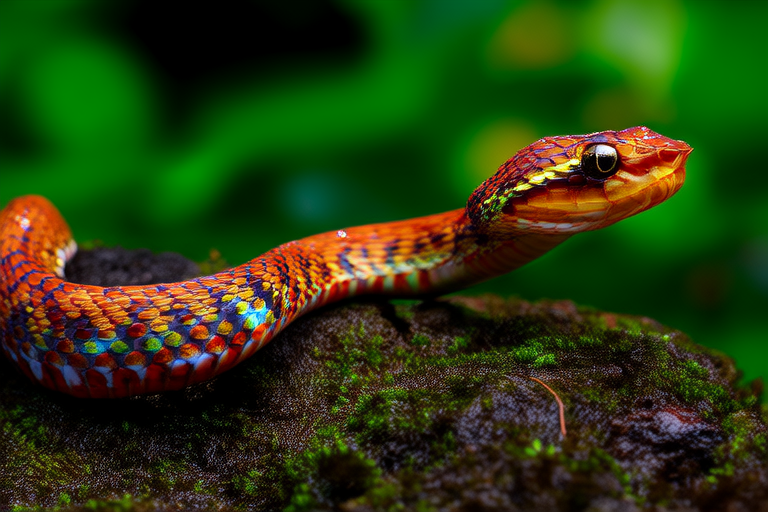From Jungle to Home: Everything You Need to Know About Adopting a Rainbow Boa
Welcome to the world of the rainbow boa! This beautiful and unique snake has captured the hearts of many reptile enthusiasts with its vibrant coloration and docile nature. If you’re considering adopting one of these magnificent creatures, this guide will provide you with all the essential information you need to ensure a happy and healthy life for your new pet.
Rainbow Boa Habitat and Diet in the Wild
The rainbow boa (Epicrates cenchria) is native to South America, where it thrives in humid rainforests and swamps. These snakes are semi-aquatic, spending time both on land and in water. In the wild, they are found in countries such as Brazil, Colombia, Ecuador, Peru, and Venezuela. The environment in which they live is warm and moist, with temperatures ranging between 75°F and 90°F (24°C to 32°C). They enjoy burrowing into leaf litter or hiding under logs and rocks, seeking refuge from predators and extreme weather conditions.
Rainbow boas are carnivorous and primarily feed on small mammals, birds, and amphibians. They have a preference for rodents but will also consume other prey items available in their natural habitat. Their hunting technique involves constriction, where they wrap their bodies around their prey to suffocate it before consuming it whole. This method ensures that they can tackle a variety of prey sizes, making them efficient hunters in their native environment.
Behavior and Care Requirements as Pets
When brought into captivity, rainbow boas can make wonderful pets due to their generally calm demeanor and adaptability. However, it’s important to note that each individual may have its own personality, so patience is key when handling them. Regular interaction helps build trust, but always approach your snake with care and respect.
Proper housing is crucial for the well-being of your rainbow boa. An appropriately sized enclosure provides ample space for exercise and exploration while maintaining optimal temperature and humidity levels. A glass terrarium or plastic tub with secure ventilation holes works well; ensure that any substrate used does not cause irritation or ingestion issues. Branches or artificial plants offer climbing opportunities, simulating natural behaviors.
Adoption Processes from Reputable Breeders or Rescues
Choosing a reputable breeder or rescue organization is vital when adopting a rainbow boa. Research potential sources thoroughly by reading reviews, asking questions about breeding practices, and requesting references if possible. Look for facilities that prioritize animal welfare over profit margins, ensuring ethical treatment throughout every stage of care.
Many reputable breeders specialize in producing high-quality specimens through selective breeding programs aimed at enhancing desirable traits like color patterns and temperament. Additionally, rescues often house animals surrendered by previous owners who could no longer provide adequate care. By supporting these organizations, you contribute positively towards responsible pet ownership within the community.
Setting Up the Ideal Enclosure
To create an ideal living space for your rainbow boa, consider several factors including size, lighting, heating, and substrate choices. A minimum enclosure size of 4 feet long x 2 feet wide x 2 feet tall is recommended for adults, allowing sufficient room for movement without overcrowding. For younger snakes, proportionally smaller accommodations suffice until growth allows for upgrading.
Lighting plays an essential role in simulating day-night cycles necessary for proper physiological functioning. Full-spectrum UVB bulbs promote vitamin D synthesis while providing visual stimulation similar to sunlight exposure. Heat lamps or ceramic heaters maintain consistent daytime temperatures between 85°F and 90°F (29°C to 32°C), supplemented by basking areas reaching up to 95°F (35°C).
Humidity levels should remain around 60-70%, mimicking tropical climates experienced by wild populations. Mist regularly using spray bottles or automatic misting systems to achieve desired moisture content. Substrates made from coconut fiber, cypress mulch, or reptile-safe paper towels work effectively, absorbing excess fluids and preventing bacterial growth.
Health Issues to Watch For
Regular veterinary check-ups are crucial for maintaining good health in captive rainbow boas. Common ailments include respiratory infections caused by poor hygiene or improper husbandry techniques, scale rot resulting from prolonged contact with wet surfaces, and parasites introduced via contaminated food sources.
Veterinarians specializing in exotic animals possess expertise tailored specifically toward diagnosing and treating conditions affecting reptiles. Signs warranting immediate attention include lethargy, loss of appetite, discharge from nostrils or eyes, swollen body regions, and unusual skin discolorations. Early intervention improves prognosis significantly, underscoring the importance of proactive monitoring.
Dietary Needs
In captivity, rainbow boas thrive on a diet consisting mainly of appropriately sized mice or rats. Offer prey items roughly equivalent to one-third the snake’s girth to avoid digestive complications. Feeding frequency depends largely upon age and size; juveniles require more frequent meals compared to mature individuals.
Pre-killed frozen-thawed rodents represent safer alternatives to live prey, reducing risks associated with injury during capture attempts. Thaw frozen prey completely before offering, ensuring optimal temperature for digestion. Supplements containing calcium and vitamins help support overall wellbeing, particularly during periods of rapid growth.
Handling Tips
Safe handling practices minimize stress levels experienced by rainbow boas, fostering positive interactions between owner and pet. Always wash hands prior to touching your snake to prevent transferring harmful bacteria or chemicals onto sensitive skin.
Use gentle yet firm grips near mid-body sections rather than tail ends, avoiding excessive squeezing which might cause discomfort. Allow your boa time to acclimate after emerging from its enclosure, gradually increasing duration of out-of-cage activities as confidence grows.
Advice for New Owners
Becoming familiar with basic husbandry principles equips prospective owners with knowledge needed to provide optimal care throughout their rainbow boa’s lifespan. Patience and consistency form cornerstones of successful reptile keeping, rewarding those willing to invest time and effort into understanding unique needs.
Join online forums dedicated to discussing topics related to snake ownership, connecting with fellow enthusiasts who share similar interests. Sharing experiences fosters learning opportunities, addressing common concerns collectively. Remember, every journey begins with taking that first step – welcome aboard!
